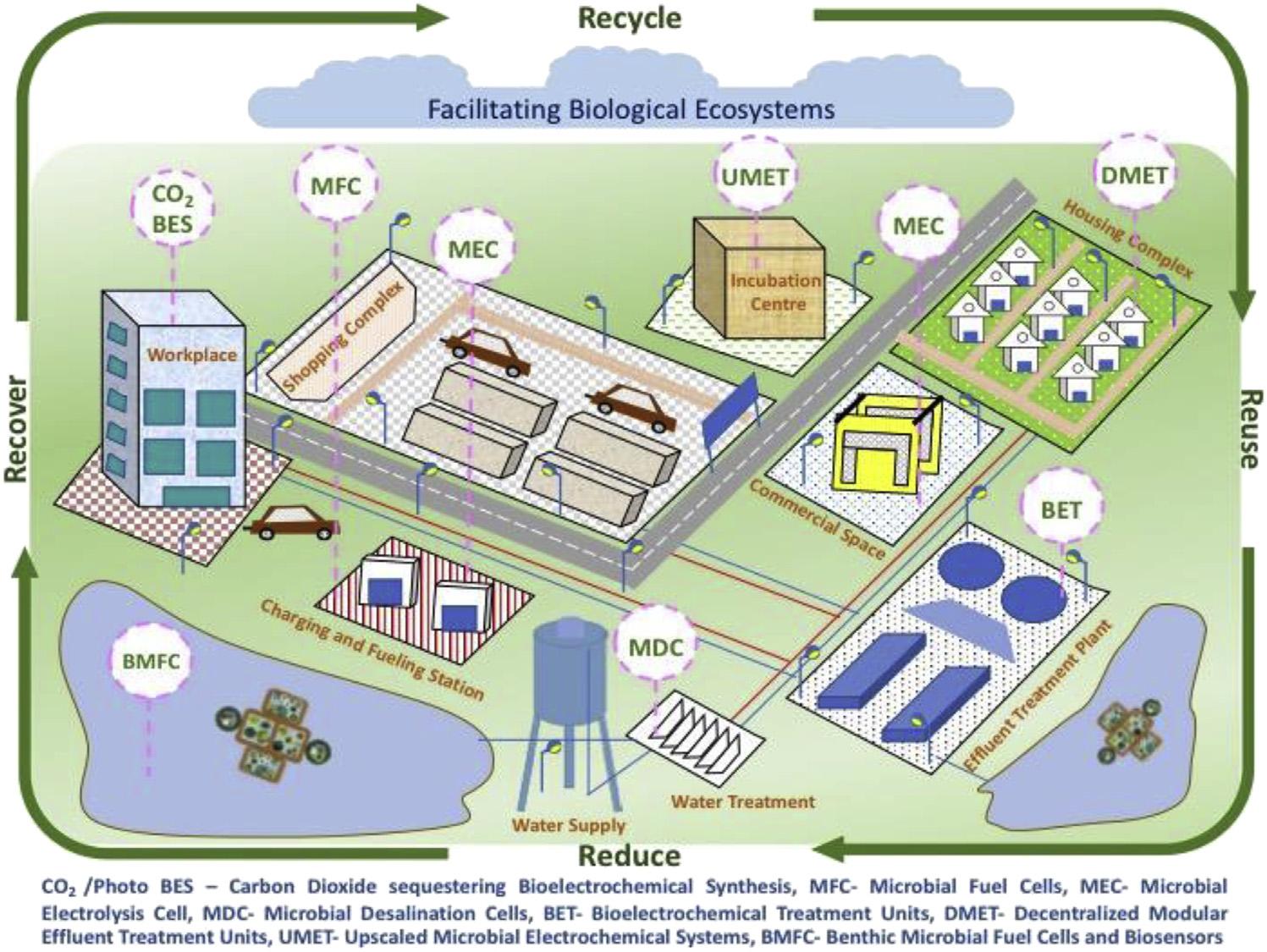Contributors
RouzbehAbbassi SchoolofEngineering, FacultyofScienceandEngineering,Macquarie University,Sydney,NSW,Australia
IbrahimM.Abu-Reesh EnergyandEnvironmentLab,DepartmentofChemicalEngineering,QatarUniversity,Doha,Qatar
JuanS.Arcila LaboratoryforResearchon AdvancedProcessesforWaterTreatment, InstitutodeIngeniería,UnidadAcadémica Juriquilla,UniversidadNacionalAutónomade México,Queretaro,Mexico
KotakondaArunasri Prof.BrienHoldenEye ResearchCentre,LVPrasadEyeInstitute, Hyderabad,India
JuanAntonioBaeza GENOCOV,Department ofChemical,BiologicalandEnvironmental Engineering,SchoolofEngineering,UniversitatAutònomadeBarcelona,Barcelona, Spain
EnricBlázquez GENOCOV,Departmentof Chemical,BiologicalandEnvironmental Engineering,SchoolofEngineering,Universitat AutònomadeBarcelona,Barcelona,Spain
AbhijeetP.Borole TheUniversityofTennessee, Knoxville,TN,UnitedStates;OakRidge NationalLaboratory,OakRidge,TN,United States
GermánBuitrón LaboratoryforResearchon AdvancedProcessesforWaterTreatment, InstitutodeIngeniería,UnidadAcadémica Juriquilla,UniversidadNacionalAutónomade México,Queretaro,Mexico
SaiKishoreButti BioengineeringandEnvironmentalSciencesLab,CEEFFCentre,CSIRIndianInstituteofChemicalTechnology, Hyderabad,India
RenéCardeña LaboratoryforResearchon AdvancedProcessesforWaterTreatment, InstitutodeIngeniería,UnidadAcadémica Juriquilla,UniversidadNacionalAutónomade México,Queretaro,Mexico
CarlosCastillo-Zacarias TecnologicodeMonterrey,SchoolofEngineeringandScience, CampusMonterrey,Monterrey,Mexico
RashmiChandra TecnologicodeMonterrey, SchoolofEngineeringandScience,Campus Monterrey,Monterrey,Mexico
K.Chandrasekhar DepartmentofCivilEngineering,YeungnamUniversity,Gyeongsan, RepublicofKorea;DepartmentofBiotechnology,NationalInstituteofTechnology, Warangal,TelanganaState,India
KaYuCheng CSIROLandandWater,Floreat, Perth,WA,Australia;SchoolofEngineering andInformationTechnology,MurdochUniversity,Perth,WA,Australia
GovindaChilkoor CivilandEnvironmental Engineering,SouthDakotaSchoolofMines andTechnology,RapidCity,SD,UnitedStates
P.Chiranjeevi DepartmentofEarthandEnvironmentalSciences,IndianInstituteofScience EducationandResearch(IISER)Mohali,India
HulyaCivelekYoruklu DepartmentofEnvironmentalEngineering,YildizTechnical University,DavutpasaCampus,Istanbul, Turkey
NazuaL.Costa InstitutodeTecnologiaQuímica eBiológicaAntónioXavier,Universidade NOVAdeLisboa,Oeiras,Portugal
DebabrataDas DepartmentofBiotechnology, IndianInstituteofTechnologyKharagpur, Kharagpur,India
AhmetDemir DepartmentofEnvironmental Engineering,YildizTechnicalUniversity, DavutpasaCampus,Istanbul,Turkey
ChirayuDesai P.D.PatelInstituteofApplied Sciences,CharotarUniversityofScienceand Technology(CHARUSAT),Changa,India
PridhvirajDesale LaboratoireGénieCivilet géoEnvironnement(LGCgE)GroupeISALille, YncréaHauts-de-France,LilleCedex,France
BiproRanjanDhar CivilandEnvironmental Engineering,UniversityofAlberta,Edmonton, AB,Canada
SangeethaDharmalingam Departmentof MechanicalEngineering,AnnaUniversity, Chennai,India
SaurabhSudhaDhiman BuGReMeDEEconsortium,DepartmentofChemicalandBiologicalEngineering,SouthDakotaSchoolof MinesandTechnology,RapidCity,SD,United States
AhmedElMekawy GeneticEngineeringand BiotechnologyResearchInstitute,Universityof SadatCity(USC),SadatCity,Egypt
AdrianEscapa ChemicalandEnvironmental BioprocessEngineeringGroup,Natural ResourcesInstitute(IRENA)-Universityof Leon,León,Spain
J.SatyaEswari DepartmentofBiotechnology, NationalInstituteofTechnology(NITRR), Raipur,India
YujieFeng StateKeyLaboratoryofUrban WaterResourceandEnvironment,Harbin InstituteofTechnology,Harbin,China
AnaP.Fernandes InstitutodeTecnologiaQuímicaeBiológicaAntónioXavier,Universidade NOVAdeLisboa,Oeiras,Portugal
BrunoM.Fonseca InstitutodeTecnologiaQuímicaeBiológicaAntónioXavier,Universidade NOVAdeLisboa,Oeiras,Portugal
DavidGabriel GENOCOV,Departmentof Chemical,BiologicalandEnvironmentalEngineering,SchoolofEngineering,Universitat AutònomadeBarcelona,Barcelona,Spain
VenkataramanaGadhamshetty Civiland EnvironmentalEngineering,SouthDakota SchoolofMinesandTechnology,RapidCity, SD,UnitedStates;SurfaceEngineering ResearchCenter,SouthDakotaSchoolof MinesandTechnology,RapidCity,SD, UnitedStates
LeiGao StateKeyLaboratoryofUrbanWater ResourceandEnvironment,HarbinInstituteof Technology,Harbin,China
VikramGaraniya AustralianMaritimeCollege (AMC),UniversityofTasmania,Launceston, TAS,Australia
RajeevK.Gautam SustainableEnvironergy ResearchLab(SERL),DepartmentofChemical Engineering,IndianInstituteofTechnology Delhi,NewDelhi,India
VeeraGnaneswarGude DepartmentofCivil andEnvironmentalEngineering,Mississippi StateUniversity,MississippiState,MS,United States
AlbertGuisasola GENOCOV,Departmentof Chemical,BiologicalandEnvironmentalEngineering,SchoolofEngineering,Universitat AutònomadeBarcelona,Barcelona,Spain
WeihuaHe StateKeyLaboratoryofUrban WaterResourceandEnvironment,Harbin InstituteofTechnology,Harbin,China
HanaaM.Hegab DepartmentofChemical Engineering,MonashUniversity,Clayton,VIC, Australia
ManupatiHemalatha BioengineeringandEnvironmentalScienceLab,CEEFFCentre,CSIRIndianInstituteofChemicalTechnology, Hyderabad,India
AbidHussain CivilandEnvironmentalEngineering,UniversityofWaterloo,Waterloo,ON, Canada
KunalJain DepartmentofBiosciences,Sardar PatelUniversity,VallabhVidyanagar,India
JennyJohnson DepartmentofBiosciences,SardarPatelUniversity,VallabhVidyanagar, India
SokheeP.Jung DepartmentofEnvironment andEnergyEngineering,ChonnamNational University,Gwangju,Korea
RameshKakarla DepartmentofEnvironmental ScienceandEngineering,KyungHeeUniversity,Yongin-si,RepublicofKorea
VidhiKalola P.D.PatelInstituteofApplied Sciences,CharotarUniversityofScienceand Technology(CHARUSAT),Changa,India
RengasamyKarthikeyan DepartmentofBiology,WashingtonUniversityinSaintLouis,St. Louis,MO,UnitedStates
JamesKilduff CivilandEnvironmentalEngineering,RensselaerPolytechnicInstitute,Troy, NY,UnitedStates
BaharehKokabian DepartmentofCiviland EnvironmentalEngineering,MississippiState University,MississippiState,MS,UnitedStates
SanathKondaveeti EnergyandEnvironment Lab,DepartmentofChemicalEngineering, QatarUniversity,Doha,Qatar
K.VamshiKrishna BioengineeringandEnvironmentalScienceLab,CEEFF,CSIR-Indian InstituteofChemicalTechnology,Hyderabad, India;AcademyofScientificandInnovative Research,Hyderabad,India
VaidhegiKugarajah DepartmentofMechanical Engineering,AnnaUniversity,Chennai,India
B.SudheerKumar MedicinalChemistryand Biotechnology,CSIR-IndianInstituteofChemicalTechnology,Hyderabad,India
A.KiranKumar BioengineeringandEnvironmentalSciencesLab,CEEFFCenter,CSIRIndianInstituteofChemicalTechnology(CSIRIICT),Hyderabad,India
A.NareshKumar BioengineeringandEnvironmentalScienceLab,CEEFF,CSIR-IndianInstituteofChemicalTechnology,Hyderabad, India;AcademyofScientificandInnovative Research,Hyderabad,India
Hyung-SoolLee CivilandEnvironmental Engineering,UniversityofWaterloo,Waterloo, ON,Canada
P.N.L.Lens UNESCO-IHEInstituteforWater Education,Delft,TheNetherlands;DepartmentofMicrobiology,NationalUniversityof Ireland,Galway,Ireland
AlexJ.Lewis TheUniversityofTennessee, Knoxville,TN,UnitedStates
DaLi StateKeyLaboratoryofUrbanWater ResourceandEnvironment,HarbinInstituteof Technology,Harbin,China
NanLi SchoolofEnvironmentalScienceand Engineering,TianjinUniversity,Tianjin, China
JiaLiu StateKeyLaboratoryofUrbanWater ResourceandEnvironment,HarbinInstituteof Technology,Harbin,China
WenzongLiu StateKeyLaboratoryofUrban WaterResourceandEnvironment,Harbin InstituteofTechnology,Harbin,China
RicardoO.Louro InstitutodeTecnologiaQuímicaeBiológicaAntónioXavier,Universidade NOVAdeLisboa,Oeiras,Portugal
DattaMadamwar DepartmentofBiosciences, SardarPatelUniversity,VallabhVidyanagar, India
ElenaI.Mancera-Andrade Tecnologicode Monterrey,SchoolofEngineeringandScience, CampusMonterrey,Monterrey,Mexico
RaulMateos ChemicalandEnvironmentalBioprocessEngineeringGroup,NaturalResources Institute(IRENA)-UniversityofLeon,León, Spain
BookiMin DepartmentofEnvironmentalScienceandEngineering,KyungHeeUniversity, Yongin-si,RepublicofKorea
J.AnnieModestra BioengineeringandEnvironmentalSciencesLab,CEEFFCentre,CSIRIndianInstituteofChemicalTechnology, Hyderabad,India
S.VenkataMohan BioengineeringandEnvironmentalSciencesLab,CEEFF,CSIR-Indian InstituteofChemicalTechnology,Hyderabad, India
GundaMohanakrishna EnergyandEnvironmentLab,DepartmentofChemicalEngineering,QatarUniversity,Doha,Qatar
AntonioMoran ChemicalandEnvironmental BioprocessEngineeringGroup,Natural ResourcesInstitute(IRENA)-Universityof Leon,León,Spain
Y.V.Nancharaiah BiofoulingandBiofilmProcessesSectionofWaterandSteamChemistry Division,BhabhaAtomicResearchCentre, Kalpakkam,India;HomiBhabhaNational Institute,Mumbai,India
G.N.Nikhil DepartmentofBiotechnology,Dr. B.R.AmbedkarNationalInstituteofTechnologyJalandhar,Jalandhar,Punjab,India
EmreOguzKoroglu DepartmentofEnvironmentalEngineering,YildizTechnicalUniversity,DavutpasaCampus,Istanbul,Turkey
BestamiOzkaya DepartmentofEnvironmental Engineering,YildizTechnicalUniversity, DavutpasaCampus,Istanbul,Turkey
AshokPandey CSIR-IndianInstituteofToxicologyResearch,Lucknow,India
SoumyaPandit DepartmentofBiotechnology, IndianInstituteofTechnologyKharagpur, Kharagpur,India;AmityInstituteofBiotechnology,Mumbai,India
DeepakPant SeparationandConversionTechnologies,FlemishInstituteforTechnological Research(VITO),Boeretang,Mol,Belgium
CatarinaM.Paquete InstitutodeTecnologia QuímicaeBiológicaAntónioXavier,UniversidadeNOVAdeLisboa,Oeiras,Portugal
AlkaPareek BioengineeringandEnvironmental ScienceLab,CEEFFCSIR-IndianInstituteof ChemicalTechnology,Hyderabad,India
PiyushParkhey AmityInstituteofBiotechnology,AmityUniversity,Raipur,India
RobertoParra-Saldívar TecnologicodeMonterrey,SchoolofEngineeringandScience, CampusMonterrey,Monterrey,Mexico
SunilA.Patil DepartmentofEarthandEnvironmentalSciences,IndianInstituteofScience
EducationandResearch(IISER)Mohali,Punjab,India
R.S.Prakasham MedicinalChemistryandBiotechnology,CSIR-IndianInstituteofChemical Technology,Hyderabad,India
NavaniethaK.Rathinam BuGReMeDEEconsortium,DepartmentofChemicalandBiologicalEngineering,SouthDakotaSchoolof MinesandTechnology,RapidCity,SD,United States;DepartmentofChemistryandApplied BiologicalSciences,SouthDakotaSchoolof MinesandTechnology,RapidCity,SD,United States
RohitRathour P.D.PatelInstituteofApplied Sciences,CharotarUniversityofScienceand Technology(CHARUSAT),Changa,India
C.NagendranathaReddy DepartmentofEnvironmentalScienceandEngineering,Kyung HeeUniversity,Yongin-si,RepublicofKorea
M.VenkateswarReddy InstitutfürMolekulare MikrobiologieundBiotechnologie,WestfälischeWilhelmsUniversitätMunster,Munster,Germany
IsaacRivera InstituteofEnvironmentaland SustainableChemistry,TU-Braunschweig, Braunschweig,Germany
ShantonuRoy DepartmentofBiotechnology, NationalInstituteofTechnologyArunachal Pradesh,ArunachalPradesh,India
DavidR.Salem BuGReMeDEEconsortium, DepartmentofChemicalandBiological Engineering,SouthDakotaSchoolofMines andTechnology,RapidCity,SD,United States;DepartmentofMaterialsandMetallurgicalEngineering,SouthDakotaSchoolof MinesandTechnology,RapidCity,SD,United States;CompositeandNanocomposite AdvancedManufacturing BiomaterialsCenter(CNAM-BioCenter),RapidCity,SD,United States
RajeshK.Sani BuGReMeDEEconsortium, DepartmentofChemicalandBiological Engineering,SouthDakotaSchoolofMines andTechnology,RapidCity,SD,United
States;CompositeandNanocomposite AdvancedManufacturing Biomaterials Center(CNAM-BioCenter),RapidCity,SD, UnitedStates;DepartmentofChemistryand AppliedBiologicalSciences,SouthDakota SchoolofMinesandTechnology,RapidCity, SD,UnitedStates
SambhuSaptoka CivilandEnvironmental Engineering,SouthDakotaSchoolofMines andTechnology,RapidCity,SD,UnitedStates
OmprakashSarkar BioengineeringandEnvironmentalSciencesLab,CEEFF,CSIR-Indian InstituteofChemicalTechnology,Hyderabad, India
UweSchröder InstituteofEnvironmentaland SustainableChemistry,TU-Braunschweig, Braunschweig,Germany
NamitaShrestha CivilandEnvironmental Engineering,SouthDakotaSchoolofMines andTechnology,RapidCity,SD,UnitedStates
AnaV.Silva InstitutodeTecnologiaQuímicae BiológicaAntónioXavier,UniversidadeNOVA deLisboa,Oeiras,Portugal
J.ShanthiSravan BioengineeringandEnvironmentalSciencesLab,CEEFF,CSIR-Indian InstituteofChemicalTechnology,Hyderabad, India
PratikshaSrivastava AustralianMaritimeCollege(AMC),UniversityofTasmania,Launceston,TAS,Australia
MoogambigaiSugumar Departmentof MechanicalEngineering,AnnaUniversity, Chennai,India
XiaohangSun DepartmentofAppliedSciences, CollegeofEnvironmentalTechnology,MuroranInstituteofTechnology,050-8585Hokkaido,Muroran,Japan
KuchiSwathi BioengineeringandEnvironmentalScience(BEES)Lab,CEEFFCentre, CSIR-IndianInstituteofChemicalTechnology, Hyderabad,India
EkantTamboli DepartmentofBiotechnology, NationalInstituteofTechnology(NITRR), Raipur,India
Pier-LucTremblay SchoolofChemistry, ChemicalEngineeringandLifeScience,Wuhan UniversityofTechnology,Wuhan,People’ s RepublicofChina
InêsB.Trindade InstitutodeTecnologiaQuímicaeBiológicaAntónioXavier,Universidade NOVAdeLisboa,Oeiras,Portugal
KarolienVanbroekhoven SeparationandConversionTechnologies,FlemishInstitutefor TechnologicalResearch(VITO),Boeretang, Mol,Belgium
JhansiL.Varanasi DepartmentofBiotechnology,IndianInstituteofTechnology Kharagpur,Kharagpur,India
SunitaVarjani GujaratPollutionControlBoard, Gandhinagar,Gujarat,India
RamyaVeerubhotla DepartmentofBiotechnology,IndianInstituteofTechnology Kharagpur,Kharagpur,India
G.Velvizhi BioengineeringandEnvironmental ScienceLab,CEEFF,CSIR-IndianInstituteof ChemicalTechnology,Hyderabad,India
BhuvanVemuri CivilandEnvironmental Engineering,SouthDakotaSchoolofMines andTechnology,RapidCity,SD,UnitedStates
AnilVerma SustainableEnvironergyResearch Lab(SERL),DepartmentofChemicalEngineering,IndianInstituteofTechnologyDelhi, NewDelhi,India
LingWang StateKeyLaboratoryofUrban WaterResourceandEnvironment,Harbin InstituteofTechnology,Harbin,China
XinWang MOEKeyLaboratoryofPollution ProcessesandEnvironmentalCriteria,Tianjin KeyLaboratoryofEnvironmentalRemediation andPollutionControl,CollegeofEnvironmentalScienceandEngineering,NankaiUniversity,Tianjin,China
Ai-JieWang StateKeyLaboratoryofUrban WaterResourceandEnvironment,Harbin InstituteofTechnology,Harbin,China
HuantingWang DepartmentofChemical Engineering,MonashUniversity,Clayton,VIC, Australia
JonathanW.C.Wong Sino-ForestApplied ResearchCentreforPearlRiverDelta Environment,DepartmentofBiology,Hong KongBaptistUniversity,HongKong,P.R. China
LichaoXia CivilandEnvironmentalEngineering,RensselaerPolytechnicInstitute,Troy,NY, UnitedStates
AsheeshKumarYadav CSIR-InstituteofMineralsandMaterialsTechnology,Bhubaneswar, India
DileepKumarYeruva Bioengineeringand EnvironmentalSciencesLab,EEFFCenter, CSIR-IndianInstituteofChemicalTechnology (CSIR-IICT),Hyderabad,India
TianZhang SchoolofChemistry,Chemical EngineeringandLifeScience,WuhanUniversityofTechnology,Wuhan,People’ s RepublicofChina
Preface
Renewableenergygenerationusing microbialcatalyzedfuelcellsisgainingprominenceforitspotentialasanalternativeand sustainableroute.Scanningthroughtheliterature,the firstreportonoriginofelectrical effectsthroughmicrobialcatalyzedreactions wasreportedbyGalvaniin1789in “frog musclestwitchingwithcopper-zinccouples.”
Subsequently,M.C.Potterin1911reported electricaleffectaccompanyingthedecompositionoforganiccompoundsinpresenceof microorganismssuchas Saccharomyces or bacteria. Itremainedasoneoftheearliest observationsuntil1980s,whereresearchon syntheticmediatorshaslightenedupthe ideaofusingbacteria-catalyzedfuelcellslater termedas “microbialfuelcells(MFC).” However,from2000onwardtheconcepthas resurfacedandgainedsignificantattention intheresearchfraternityduetoitsinherent scopeforwiderapplication,initiallywith speci ficfocusonrenewableenergygenerationandlaterbyintegratedwithwaste remediation.
Understandingonthisconcepthasbeen rapidlystretchedtocoverseveraldomains andapplicationssincethepast15years,givingrisetodevelopmentof “microbialelectrochemicaltechnology(MET)” asa platformtechnology.Inthiscourseofdevelopment,METshavesprungintocurrent researchpavinganewfoundpathforrenewableenergy/fuelgeneration,chemicalssynthesis,andwasteremediation.METswith theirmalleablenaturehavebeensignificantlydiversifiedto findtheirapplications inbioelectricitygeneration(asMFC),
bio-basedplatformchemicalsynthesis (asbioelectrochemicalsystems[BES]), hydrogen/methane/hythaneproduction(as microbialelectrolysiscell[MEC]),water desalination(asmicrobialdesalinationcell [MDC]),enhancedbioprocess(aselectrofermentation[EF])andwasteremediation(as bioelectrochemicaltreatmentsystem[BET]). Eachofthesebio-electro-mediatedprocesses canbeindividuallyintegratedwith acidogenesis,photosynthesis,andbioanoxygenesiscascadicallytoclosetheloop enablingazerowastetechnology.METcan bepotentiallyestablishedasasustainable alternatewiththeenergyharnessedbeing clean,green,andrenewableinnature.These applicationsinnumerousmundaneactivities haspotentialtolowerthecarbonfootprint ontheenvironmentandgarnersigni ficance towardabio-basedcircularbioeconomy.
Inthiscontext,thisbook “Microbial ElectrochemicalTechnology:SustainablePlatformforFuels,ChemicalsandRemediation” aimstocomprehensivelybringforththe recentscientificdevelopmentsinthis domain.Thisbookaimedtodisseminate thewideinformationondiverseapplications ofMETsatonejunctureasasinglesource, describingdetailsaboutmaterials,biocatalysts,design,andconfigurationsaswell asunderstandingtheprocessmechanism. Theprimaryfocusistodrawattentionin termsofimprovingmicrobialelectrometabolism,bioelectrogenesis,multipleproductsynthesis,complexwasteremediation,carbon dioxidesequestration,etc.,alongwithdiscussingthemajorbottlenecksthatneedto
beaddressed.Theinterdisciplinaryapproach encompasseselectrochemistry,materialscience,microbiology,bioengineering,energy engineering,environmentalmanagement, etc.,thatareessentialtoscaleuptheprocess witheconomicviabilityandsocioeconomic acceptance.Thechapterswerewrittenby experiencedresearcherswhohavebeen workingintheinterfaceofelectrochemistry andbiotechnology.TheprogressanddevelopmentsinMETwerecomprehensivelyoutlinedundersixbroadthemes.
• Microbialelectrochemicaltechnology (MET) basics
• Electromicrobiologyandelectrontransfer mechanism
• Microbialfuelcell:powerproduction
• Bioelectrochemicaltreatmentsystems: wasteremediation
• Bioelectrochemicalsystemsforbiofuels andchemicals
• Applicationsandbioelectrore finery
Thebookintendstodissipatecomprehensivetransferofessentialknowledgetoresearchers,students,andscienceenthusiasts providingacompleteviewofMETs,detailingthefunctionalmechanismsemployed andvariousoperationalcon figurations, influencingfactorsgoverningthereaction progressandintegrationstrategies.The bookalsoprovidesintricatedetailsoneach individualparameteressentialforevolving ofMETfromabenchscaletopilotscale,offeringmultipleproductsynthesisand resourcerecovery,essentialforrenewable energyandchemicalindustrialsector,water treatmentbodies,policymakers,etc.,documentingthefollowingfeatures:
• Holisticviewofthemultipleapplications ofMETsinaunifiedcomprehensible mannermakingitasinglepointofreferenceofanyqueryinoperationor application.
• Widenedscopeoftheexistingtechnologiesgivingup-to-datestate-of-the-artinformationandknowledgeinvarious aspectsforresearchand commercialization.
• Topicsprovidinginterdisciplinary knowledgeontheelectrochemistry, microbiology,materialscience,environment,molecularbiology,engineering, biotechnology,andeconomicaspects.
• Comprehensivesourceofunderstanding theprocessandparametersbecominga richsourceofknowledgeforpractical applicability,socioeconomicimpact,and costenergyanalysiswithmorethan75 illustrations, figures,diagrams, flow charts,andtables.
• ProvidesstrategicintegrationsofMET withvariousbioprocessthatareessential inestablishingacircularbiorefinery. Theeditorswouldliketoexpresstheir sinceregratitudetotheauthorsforsubmitting theirworkpreciselyandtimelyandalso revisingitappropriatelyatashortnotice. Editorsaregratefultothereviewersfortheir precioustimeandcontributioninsignificantlyreviewingvariouschaptersofthis bookandprovidingtheirvaluablesuggestionstoimprovethemanuscripts.We acknowledgethesupportreceivedfrom Elsevierteam,speciallyDrKostasMarinakis, SeniorBookAcquisitionEditor;MsHilary Carr,BookProductionManager;andMr PremKumarKaliamoorthiandothersinthe publishingteamfortheirsupportinbringing outthisbook.
Editors
S.VenkataMohan SunitaVarjani AshokPandey
CHAPTER
MicrobialElectrochemical Technology:Emergingand SustainablePlatform
S.VenkataMohan1,J.ShanthiSravan1,SaiKishoreButti1, K.VamshiKrishna1, 2,J.AnnieModestra 1,G.Velvizhi1, A.NareshKumar1, 2,SunitaVarjani3,AshokPandey4
1BioengineeringandEnvironmentalScienceLab,CEEFF,CSIR-IndianInstituteofChemical Technology,Hyderabad,India; 2AcademyofScienti ficandInnovativeResearch,Hyderabad, India; 3GujaratPollutionControlBoard,Gandhinagar,Gujarat,India; 4CSIR-IndianInstitute ofToxicologyResearch,Lucknow,India
1.1.1INTRODUCTION
Theconceptofelectrochemicalenergysystem, i.e.,microbialelectr ochemicaltechnology (MET)functioningwiththebiologicalinte rventionsisanemergingareaforbasicand appliedresearchinthelastdecade.METapplicationisreportedindiversedomains,viz., bioenergy,wasteremediation,CO 2 sequestration,bioelectronics,resourcerecovery,desalination,etc.Itsbasicadvantageliesinits fl exibilitytovalorizeanyformofwaste(solid, liquid,andgaseous)togenerateaspectrumofproducts(electricity,biofuel,biogas,platformchemicals)inasustainableway [1 3] .Thesystemsarebasicallyhybridinnature andareinterdisciplinarywithcohesiveaggregationofvariousareas, viz.,electrochemistry, microbiology,environmentalengineering,materialsciences,biochemistry,andmanyother relatedareas [4 9] .Basedonitsapplications( Fig.1.1.1)METcanbebroadlyclassi fi edinto microbialfuelcell(MFC)togeneratebioelectricityandbioelectrochemicaltreatment(BET) systemtotreatcomplex,recalcitrant,andhighstrengthwastewaters;microbialelectrolysis cell(MEC)forhydrogenandmethaneproduction;microbialelectrosynthesissystem(MES) togenerateplatformchemicals;microbialdesalinationcell(MDC)toseparateions;and
1.1.MICROBIALELECTROCHEMICALTECHNOLOGY
FIGURE1.1.1 ApplicationsofdiverseMETsforbio-basedproductrecoveryfromvariouswastefeedstocks. BES, bioelectrochemicalsystem; BET,bioelectrochemicaltreatment; EF,electrofermentation; MDC,microbialdesalination cell; MEC,microbialelectrolysiscell; MET,microbialelectrochemicaltechnology; MFC,microbialfuelcell.
electrofermentation(EF)toenhancebio-basedproductsynthesis [10 19].Everyindividual applicationofferssubstantialadvantagesfromenvironmental,econ omic,andtechnical perspectives.
1.1.2MICROBIALELECTROCHEMICALTECHNOLOGYORIGIN
TheoriginofelectricaleffectsthroughbiologicalcatalyzedreactionswasreportedbyGalvaniin1789whenheobservedthatfrogmusclestwitchedwithcopper-zinccouples [20], whichisprobablytheearliestobservationon “physiologicalprocessesaccompaniedbychemicalchangesassociatedwithelectricalchanges.” Fig.1.1.2 depictsanoverviewoftheorigin andhistoryofMET.Afteraconsiderablegap,in1911M.C.Potterreportedmicrobialinducedelectrodereduction,whichhasledtothedevelopmentofbiofuelcells,latertermed as “microbialfuelcell(MFC)” [21].Thechemicalenergystoredinthebondsoforganic substrateiscatalyzedbytheactionofbacterialmetabolismproducingelectricalenergy, throughacascadeofredoxreactionsinadefinedfuelcellsetup.Contrarytothefuelcell, MFCusesbiologicalorganismstocatalyzetheelectrochemicalreactionswhichareanalogous toaninorganiccatalyst.ThisbioenergyobtainedfromMFCisrecognizedasanalternativeto
Galvani 1789
(Observed electrical effects in biological catalyzed reactions)
Thrustonet al., 1985 (Reported on glucose metabolism and its stoichiometry of product formation in MFC )
M C Potter in 1911
(Worked on microbial induced electrode reduction and thus lead to the development of biofuelcells later termed as MFC)
Karubeet al., 1977
(Studied anodic reaction of C. butyricum as biocatalyst and reported constant current of 1.1 to 1.2 mA)
BranetCohen in 1931
(Extended Potter’s work with stacking type of microbial fuel cell)
Davis and Yarbrough 1962
(Experiments using microbes with hydrocarbons as substrate)
Kim et al., 1990 (Patented the process of microbial desulfurization utilizing bioelectrochemical energy)
Allen and Bennetto in 1993 (Bacterial culture immobilization for electricity in MFC )
Year 2000 onwards (Microbial electrochemical technologies were extensively evaluated and published)
Microbial Fuel Cell (MFC)
Bioelectrochemical System (BES)
Microbial Electrolysis Cell (MEC)
FIGURE1.1.2 Originandtransitionofmicrobialmediatedelectrochemicalsystems. 1.1.2MICROBIALELECTROCHEMICALTECHNOLOGYORIGIN
Bio-Electrochemical Treatment (BET)
Microbial Desalination Cell (MDC)
Microbial Electrofermentation (MEF) MET’s
theconventionalfuelsthatreducestheglobalcarbonfootprintifapplied.Potterhadexperimentedwithaspecialtypeofgalvaniccellsusingplatinumelectrodestodeterminetheelectromotiveforce(EMF)developedduetothedisintegrationoforganiccompoundsby microorganismsthroughfermentativeactivity.Thestudyinferredamaximumpotential differenceof0.3 0.5Vwhentheexperimentswereperformedwithmicroorganisms [21]. BarnettCohenin1931stackedsixcellsusingyea stasabiocatalystandglucoseassubstrate anddevelopedabatterywithanoutputof35V(2mA) [22] .Healsousedpotassiumferricyanide/benzoquinoneasarti fi cialelectronmediators.In1962,DavisandYarbroughstudiedmicrobesfunctioninutilizinghydrocarbon [23] .Electricaloutputwasnotdetected whenethanewasusedasthesolesubstrate.
DucaandFuscoein1964explainedthethermodynamicspertainingtobioelectrochemical energyconversionalongwiththechangesinelectrodepotentialduringthebiochemical reactions [24].ThereportalsosuggestedMETtohaveapplicationinfourgeneralareas, viz.,aspowersources,detectorsofspecificcontaminantsinlowconcentrations,sensorsfor generationofcontrolsignals,andcatalystsforthegenerationofelectrochemicalreactions [24].In1977,Karubeandco-workersstudiedanodicreactionsofabiochemicalcellbyusing
immobilized C.butyricum asabiocatalystandreportedaconstantcurrentof1.1 1.2mA alongwithsimultaneousproductionof0.6molofhydrogenand0.2molofformicacid from1molofglucose [25].Thestudyconcludedthatcarbohydrates,lipids,andproteins arenotusuallyelectroactive,buttheintermediatesformedduringthebiologicaloxidation maybeactiveattheelectrode.Matsunagaandco-workers [26] reportedmicrobialsensor composedofimmobilizedmicroorganismsandelectrochemicaldeviceswithoxygenelectrode andfuelcelltypeelectrode.Davisandco-workers [27] usedisolatedenzyme(dehydrogenase) tocatalyzeoxidationreactionsofmethanolnearanodeofanenzymaticfuelcell.Thruston etal., [28] reportedglucosemetabolismanditsstoichiometryofproductformationusing thionine-mediated Proteusvulgaris fuelcellandrelatedtothecoulombicyield.
After1990,researchonMFChasgraduallygainedinterest.Kimandco-workersin1990 patentedamicrobialdesulfurizationprocessutilizingbioelectrochemicalenergytocatalyze thereductionofasulfurcompoundforhydrogensul fideproduction [29].AllenandBennetto in1993reportedMFCoperatedwithimmobilized Proteusvulgaris onthesurfaceofgraphite forelectricityproduction [30].ThestudieswereeventuallyshiftedlatertowardsmediatorlessMFCwithemphasisonthemechanismofelectrontransferbybacteria.From2000 onward,researchonMFCwasintensifiedwithsignificantattentionofresearchers.Thekey roleofalltheMETsisdependentonwiringofmicrobialmetabolismtosolid-stateelectrodes, viaaprocesstypicallyreferredtoasextracellularelectrontransfer(EET) [31].Usageofmixed cultureasinoculumandwaste/wastewaterassubstrateshowedsignificantimpactonthe economicsandenergyintensivenessofMETs.METshavealsogainedtheattentionamong environmentalengineersandbiotechnologistsandgraduallydiversifiedbasedontheir speci ficapplications.
1.1.2.1ScientographyofMET
AccordingtotheClarivateAnalyticsWebofSciencereport(5thMarch,2018),research publicationsintheMETdomainareincreasinggraduallywiththecourseoftime (Fig.1.1.3and1.1.4).Atpresent,atotalnumberofresearcharticlesof11,183with2,82,060 citationsareinrecords.AmongMETs,MFCcontributedhighnumberofpublications followedbyBES,MEC,BET,andMDC.InthecaseofMFC,thetotalnumberofresearch articlesrecordedwas7,537with2,08,620citations.Ontheotherhand,BESstoodatsecond placewith1,584researcharticleswhichcontributedto29,946citations.MECandBETare alsoemergingareas,whichcontributedto972and694researcharticleswith23,843and 12,311citationsrespectively.MDChasrecorded396researcharticlesandresultedin7340 citations.Thisstatisticsdepictsthesignificanceandmomentumthatisbeinggainedfor METresearch.
1.1.3MICROBIALSYSTEMSASSOCIATEDWITHENERGY GENERATION
Earlyresearchonelectro-physiologyacquaintedtheconceptof “ physiologicalprocess accompaniedbyachemicalchangeinvolvinganalliedelectricalchange ” [21] .Apparently, 1.1.MICROBIALELECTROCHEMICALTECHNOLOGY
FIGURE1.1.3 Scientographyofindividualmicrobialmediatedelectrochemicalsystems.
theobservationoflightstimulusbeingabsorbe daselectricalenergyinphotosynthesishas driventowardsconceptionofanideathataresultofdissociation/associationgenerates current.Tocon fi rmthisideaofelectricalenergygeneration,preliminaryexperiments werecarriedouttodetermineifanyEMForpotentialdifferencewasdevelopedby
1.1.MICROBIALELECTROCHEMICALTECHNOLOGY
*MFC: Microbial Fuel Cell, BES: Bioelectrochemical System, MEC: Microbial Electrolysis Cell, BET: Bioelectrochemical Treatment, MDC: Microbial Desalination Cell, MES: Microbial Electrochemical System
FIGURE1.1.4 Year-wisepublishedpapersandcitationindicesofdifferentmicrobialelectrochemicaltechnologies. ClarivateAnalyticsWebofSciencereport(5thMarch-2018).
fermentativeactivityofyeastorbacteria [23] .Asimpleyeastglucoseexperimentwas designedandcarriedoutinagalvaniccell,whichgeneratedEMFbyglucosemetabolism andhasgivenpromisingleadsforinvestigatingthisconceptfurther [22].Thevoltage/ EMFregisteredinyeastglucosecellswasrecognizedtobetheeffectofchargecollected inthefermentingliquid.Itwasalsoobserve dthatsomeenzymespartlycontributetopotentialdifference/voltagegeneration.Consec utively,fewexperimentswerecarriedoutusingbacterialspecies,speci fi cally Bacillus asbiocatalystinthegalvaniccellcontaining nutrientmediumwhichdepictedconsiderablegrowthalongwithcurrentandEMF.It wasobservedthatbiochemicalsystemssuchaswhole-cellorganism/crystallized enzyme/cell-freeextracts cangenerateammonia,hydrogenormethanolfromcomplex organicrawmaterialssuchasstarch,protein,fats,sugars,urea,etc.assubstrate [32].These studiesconcludedthatelectrodematerialscaneffectpotentialdifference,andtheelectrical energygenerationisdependentontheactivityofmicroorganism,nutrientavailability,temperature,etc. [25] .
Biologicalsystemsareassociatedwithenergytransferreactionsofoxidation/reduction reactions.Therelationbetweenfreeenergychangeandstandardredoxpotentialofbiological reactionscanbedeterminedthroughthesecondlawofthermodynamics,whichwillprovide aholisticviewofbioenergetics [33].Ingeneral,fromathermodynamicperspective,areaction isdefinedas “spontaneous” or “non-spontaneous” basedonthefreeenergychangeandthe redoxpotential.Electrontransferfromonecompoundtotheotherisinturndependenton redoxpotentialsbetweenelectrondonorandacceptor.Thetendencyofaredoxreactionto
occurdependsupontherelativeelectronaffinityoftheacceptorinaredoxpair,whichcanbe facilitatedeitherthroughenzyme/cytochromecomponents/proteins/intermediateorganic orinorganiccompounds.Electronswilltendto flowfromthehalfcelloflowerstandard reductionpotentialtothehalfcellofhigherstandardreductionpotential.Thedirectionof electron flowdependsupontherelativeelectronconcentrationorpotentialofthetwocells. Theelectronaffinityofdonorsandacceptorsbasedonthestandardredoxpotentialis depictedin Fig.1.1.5.Thecompoundswithpositivestandardreductionpotentialactas strongoxidizingagentsthatwillhavethetendencytoacceptmoreelectrons,whileitis vice-versainthecaseofreducingagents.Experimentswerecarriedoutusingeither enzymeorwholeorganism catalyzedredoxcouplesunderlaboratoryconditionsforenergy generation [2,33].
Pyruvate/Acetate[-0.7]
CytochromebC1
Cytochrome C
Cytochrome
2H+/H2 [-0.42]
LaticAcid/Xanthine[-0.39]
CO2/Methanol[-0.38]
Gluconolactone/Glucose[-0.36]
Cystine/Cysteine[-0.33]
NAD/NADH2 [-0.32]
CO2/Acetate[-0.28]
Acetaldehyde/Ethanol[-0.2]
Pyruvate/Lactate[-0.18]
Oxaloacetate/Malate[-0.16]
Fumarate/Succinate[0.02]
Ubiquinol/Ubiquinone[0.1]
NO3-/N2 [0.74]
Fe3+/Fe2+ [0.76]
O2/H2O [0.82]
FIGURE1.1.5 Standardredoxpotentialsreportedwithstandardhydrogenelectrode(SHE)involts(V)for severalbiologicalredoxmediators.
Acetate/Acetaldehyde[-0.58]
1.1.4ELECTROGENS
1.1.4.1ElectronTransferandConservationofEnergy
Microorganismsgainenergybyrespiration,catalyzeredoxreactionsorbreakdown reducedorganic/inorganiccompounds.Electronsaretransferredfromadonor(reduced substrate)toaterminalelectronacceptor,makingthedonoroxidizedandacceptorreduced. Theenergyreleasedbybreakdownofreducedsubstratewillbecapturedbynicotinamide adeninedinucleotide(NAD), flavinadeninedinucleotide(FAD),etc.Variousbiocatalysts thatcanbeusedinMEToperationaredepictedin Fig.1.1.6.Bacteriacanextracellularly transportelectronsbyoutermembranecytochromes,nanowiresandendogenousmediators, whilealgaeandyeastcantransportelectronsextracellularlybydirectandmediatedelectron transport.WhenNADandFADtransferelectronsto fi nalelectronacceptorssuchasoxygen andnitrates,electrontransportchain(ETC)conservesaportionoftheenergywhiletransferringelectronstothe fi nalelectronacceptor.Theseelectronscanbeharvestedbyusing bioelectrochemicalsystemsanscanbeconservedinseveralformslikebioelectricity, biohydrogen,etc(Fig.1.1.7).Electrontransferfromreducedsubstrateto finalelectron acceptorwillbeusedtotransportprotonsacrosstheinnermembrane,thusgeneratingan electrochemicalprotongradientwhichis fi nallyusedforgeneratingenergy [34].Unlike

FIGURE1.1.6 VariousbiocatalystsusedinMETsandtheirmodesofextracellularelectrontransport.
FIGURE1.1.7 Extracellularelectrontransportforbio-basedproductsynthesis. EET,extracellularelectron transfer; IM,innermembrane; OM,outermembrane; VFA,volatilefattyacid.
fermentation,respirationofmetalsoranyotherelectronacceptorsneedstransferofelectronsfromandonortoanacceptorwhileconservingtheenergy.Respirationenablesbacteriatouseawiderangeofsubstrates [35].
Somemicroorganismscanconserveenergytosupportgrowthbycouplingtheoxidationof reducedorganiccompoundswiththereductionofmetalssuchasiron,manganese,etc.or electrodes [36].Althoughironisknowntobeakeycomponentofseveralredoxproteins involvedinanETCtotransferelectronsfromanelectrondonortoterminalelectronacceptors suchasoxygen,sulfate,nitrates,etc.,ithasonlybeenrecentlyfoundthatitcanalsoserveas anelectronacceptor.Bacteriawhichusemetalsasterminalelectronacceptorshaveanimportantroleinthegeochemistryofaquaticsediments,submergedsoilsandtheterrestrial subsurface.
Bacterialrespiratorypathwayshavegreaterdiversityofelectrontransferduetotheirabilitytoutilizeawiderangeofsubstratesandelectronacceptorscomparedwitheukaryotes. Thisismainlybecauseofthevastarrayofnaturalhabitatswherebacteriacanliveandtheir modesofmetabolism.Respiratorysystemsandelectrontransportsystemsarebranched, signifyingtheadaptabilityofbacteria [37].Dehydrogenasesandoxidasesconnectedbyquininesandbranched.ETClinkshighenergycompoundssuchasNADandFADwith final electronacceptorssuchasoxygen,nitrates,sulfates,andmetals/electrodesinthecaseofelectroactivebacteria(EAB).CarriersandmechanismofextracellularelectrontransportinEAB varyfromorganismtoorganism.Thecytoplasmicmembraneistheprimarybarriertothe externalenvironmentandthecenterofelectrontransfer,whichisessentialformicrobialenergygeneration.However,themicrobialcellenvelopeoftenincludesotherexternalstructural components,suchaspeptidoglycan,theoutermembrane,andtheS-layer,whichare
1.1.MICROBIALELECTROCHEMICALTECHNOLOGY
electricallynon-conductiveandphysicallyimpermeabletominerals.Themajorityoforganismsthatperformthemetabolicoxidationorreductionofmetalspeciestransportselectrons tothecellsurfacewherethecatalyticredoxreactiontakesplace.Bacteriathatutilizeminerals/electrodesasterminalelectronacceptorsrequirethetransportofelectronsgenerated inthecytoplasmtobetransportedtothesurfaceofthecell.Forbacteriathatuseminerals asanelectronsource,theelectronsmustbebroughttothecytoplasmicmembraneinorder toreduceterminalelectronacceptors.Theoutermembraneofgram-negativebacteriaisan insulatingbarrierthatrequiresaconduitforelectronpassage,whileingram-positivebacteria,thecellouterwallactsasabarrierbetweenthecellandmineralsurface.Consequently,in ordertotransferelectronsfrominsidethecelltothecellsurface,bacteriauseadiverserange ofco-factorrichproteins.Awiderangeofmicrobeshavebeendiscoveredtobeabletoexchangeelectronswithsolidsurface(directEET)and/orsolublemediators(indirectEET), butonlyafewhavebeenstudiedindepth.Infact,themechanismsofelectrontransport thatarefoundindifferentspeciesdiffersigni ficantlyfromoneanother [38].
AsmetalelectrodesandseveralmetalionslikeFe(III)andMn(IV)arepracticallyinsoluble inwaterunderphysiologicalconditions.Bacteriausingtheseinsolubleelectronacceptors needtoexportelectronstoreducethemextracellularlyastheycannotimportthesemetalspecies [39].Theelectronsaretransferredfromthebacterialcelltotheinsolubleelectronacceptor eitherthroughdirectcontactbetweenthemandamineralsurface/electrodeorfacilitatedby solubleredoxmediatorssuchas flavins,phenazines,methylviologen,humicacids,etc.The reasonforhighelectrochemicalactivityof Shewanellaoneidensis and Geobactersulfurreducens is duetocellsurfacec-typecytochromes.Theferricreductaseof Geobactersulfurreducens isa complexproteincontainingc-typecytochromesandFADwhichisinvolvedinreductionof ferricions [40].ManyFe(III)reducersareelectrochemicallyactiveandcapableofexchanging electronswithanelectrode.Theymetabolizeelectrondonorswiththeelectrodebeingusedas anelectronacceptororelectronsink.ExpressionofgenesinvolvedinEETdependsonseveral factorssuchaselectrondonor,acceptor,availableoxygen,quorumsensing,etc [41].
1.1.5WEAKELECTRICIGENS THEFUTURISTICANDVERSATILE MICROBIOME
METswhicharededicatedtowardsspecificapplicationsbasedonterminalelectronacceptorsemploydiversemicrobiomesasabiocatalyst.InanMFC,exoelectrogensareconsidered vitalastheirelectrontransfermechanismishighlyregulatedandspeci fiedtowardselectrode/metalasasolidelectronacceptor.However,themicrobialcommunitythathasbeen observedinseveralMFCstudiesnotonlypossesshighlyelectroactivebacteria(EAB)and exoelectrogensbutalsootherbacteriathatarenotelectrogenicandcanperformmoderate electro-activity,recentlyemergingas “weakelectricigens ” [42].PhylogeneticanalysisobtainedfromseveralstudiesrevealedmostoftheEABbelongtogram-negativeclassi fication, whilemoderate/weakelectricigensaregram-positive,withthestructuraldifferenceincell wallanditscompositionbeingthekeyfactorindeterminingtheelectroactivity [43].These weakelectricigenstypicallyrelyonsolubleelectronacceptorsandcanalsousesolidelectron acceptorsundercertainstress/variableconditions.AstheresearchtransitionhasbeenenvisionedtowardsbiotechnologicalandbiomedicalapplicationsusingtheprincipleofMET,
theseweakelectricigens findimportanceinthisemergingdomain,distinctfrompowergeneration [44].Weakelectricigensarecapableofgrowinginarangeofdifferentenvironments andcancompensateforspeci fiedmetabolicshortcomingsofanEAB,facilitatingastablebioprocessinamixedmicrobiome [45,46]
Thepotentialapplicationofweakelectricigenis “bioelectrosynthesis” foracetate,and methanesynthesisusingcathodicmicrobiomehasbeenexpandingtowardselectrofermentationaswell [1,17,47].Boththeseprocessesemployelectricalstimulitosteerandenhancethe metabolicratesofmicrobes(weakelectricigens),aswellasendproducts.Understandingthe microbialecologyofweakelectricigenswouldbroadenthescopeandapplicationstowards speci ficproductsynthesisandbioremediationofspeci ficcompounds,recoveryofmetals, etc.,althoughthecolumbicefficienciesareless [48 50].Besidesthisdiversity,scalability and flexibilityisconsideredasakeytothefunctioningofMETbytakingintoaccountthe emergingweakelectricigenstobeadaptabletowardsyieldingmaximumproductivity [48]. Noveltechniquetoscreenandenrichweakelectricigensformulti-facetedapplicationsis possiblethroughelectrochemicallycontrolledexperiments(potentiostatically)athighoxidativepotentials.Currentapplicationsofweakelectricigensmajorlyalignwiththe fieldof whitebiotechnologysuchaselectrofermentationandbioelectrosynthesis,whichisgaininginterestinthecurrentresearchscenario.Explorationoftheseprocesseswouldgreatlyimpact thebiotechnology fieldintermsoftransitioningfromlinearfossil basedeconomytobiobasedeconomy.
1.1.6CONCLUSIONSANDPERSPECTIVES
METisanemergingplatformandhavethescopetobecomedisruptivetechnologydueto itsdocumentedapplicationsinmultipledomains.METifsuccessfullydeployedtoapplicationwillhaveacriticalimpactondiversespheresofactivity,speci ficallyinthedomainof wastemanagementandresourcerecoveryalongwithbioenergygeneration[Fig.1.1.8]. MFCstosomeextentcanbeusedastheadditionalenergysourceinruralandremoteareas wherethereisnoenergysupply [51].However,theenergygeneratedbyindividualMFCsis ofaveryloworder,andtoachieveapplicability,upscaledversionwithstackingisneeded. TheabilityofMETtoremediatecomplexwastewaters/industrialeffluentswhilesimultaneouslygeneratingenergyandbiobasedproductsgivesitanadvantageoverthepre-existing wastemanagementtechnologiesandpractices [52 55,11,12].Moreover,mostoftheconventionalwastetreatmenttechnologiesconsumerelativelylargeamountsofenergyfortreating wastes,whichoftenmakestheprocessenergyintensiveandtheenergypossessedinthe wasteremainsuntapped.The fluegasesfromtheindustrymajorlyconsistofCO2,CH4 andCOalongwithNOx/SOx.METhasthecapabilitiestoutilizethesegasesasfeedstock forsynthesisofvalueaddedproducts.CO2 sequestrationthroughMETisanemerging domainofalternativeroutesforplatformchemicalssynthesis [56 59].METscanalsobe deployedtotreatsaltsasMDC [60].UpscaledversionsofMFCscanbedeployedinlakes forecologicalrestorationbybenthicMFCs,whichcanalsobeusedasbiosensorstomonitor theoverallpollutionlevelsoranyspecificpollutants [48,61].Themicrobesarespeci ficto environmentandgivediscreteresponsetoanychangeswhichcanbecapturedasan

FIGURE1.1.8 Variousapplicationsandlocationswheremicrobialelectrochemicaltechnologycanbeincorporatedandenablethedevelopmentofasustainableecosystem.
analogouselectricalsignalbyMET(inherentsensingcapability).Recentdevelopment,electrofermentationcanbeemployedforthecommoditychemicalsynthesis [1,5,17,18].
Inthecurrentscenario,METshavenotyettakentheleapforcommercialization.However, continuous,systematicandcross-disciplinaryresearchisessentialrequirementtoovercome theissues.Thecriticalparametersthatneedtobeextensivelyunderstoodaremicrobialphysiology,systemdesign,materials,interfaceofbiologyandmaterials,etc.whichwouldenable inovercomingthelowefficiency,limitedreliabilityandcomplexscalability [2,4,62].UnderstandingtheEETmechanismsandmicrobialphysiologyinarationalmanneriscriticalfor betterdesignofthesehybridsystems.Recentadvancesshowedthatthequantummechanics caninfluenceseveralbiochemicalreactions,especiallyelectrontransportandredoxenzymes. Quantumfunctioninbiologicalsystemscalledasquantumtunnelingmighthelpinunderstandingthemovementofelectronsthroughabarrierinaquickandefficientway [63] Tunnelingcurrentisproducedbyelectronswhentheymovethroughabarrierthatshould notactuallybeallowedtopass.Inbiologicalsystems,electrontransfermayoccurbydelocalization,tunneling,superexchangeandredoxconduction.Whileallthemechanismshavean equalroleinelectrontransport,tunnelingtendstodominateovertheshortdistances (< 2mm) [64].Tunnelingphenomenawasfoundinseveralelectrontransportproteinslike respiratorycomplexIorNADHdehydrogenaseI [65].Understandingofthesemechanisms
isafundamentalscienti ficchallengeandcangiveleadstodesignmolecularredoxmachines withimportanttechnologicalapplications.Themicrobe-electrodeinteractionsonthestructuralandfunctionaldevelopmentofamicrobialcommunitygoverntheexo-electrogenic efficiency.Speci ficelectrodesanditsmaterialwithgoodcatalyticactivity,biocompatibility andcosteffectivenessisanotherdomainthatneedtobepursued [62,48].Advancedanalytical toolshelptounderstandtheinteractionsofexo-electrogenicmicrobeswithelectrodematerialsindetail.METhasthepotentialtodrivethecurrentfossilbasedlineareconomyinto aself-sustainedbioeconomy.Multidisciplinaryresearchinthisdomainisessentialforits translation.
Acknowledgments
AuthorsatCSIR-IICTacknowledgethe financialsupportfromDepartmentofScienceandTechnology(NewIndigo Project;DST/IMRCD/NewIndigo/Bio-e-MAT/2014/(G)/(ii)).GVacknowledgesDSTforSERB-Grant(YSS/2015/ 001438).JSS,ANK,KVKandJAMacknowledgeCSIRforprovidingresearchfellowship.SKBacknowledgeUGCfor providingresearchfellowship.
References
[1]S.VenkataMohan,J.A.Modestra,K.Amulya,S.K.Butti,G.Velvizhi,Acircularbioeconomywithbio-based productsfromCO2 sequestration,TrendsBiotechnol.34(6)(2016)506 519.
[2]S.K.Butti,G.Velvizhi,M.L.K.Sulonen,J.M.Haavisto,E.O.Koroglu,A.Y.Cetinkaya,S.Singh,D.Arya, J.A.Modestra,K.V.Krishna,A.Verma,B.Ozkaya,A.Lakaniemi,J.A.Puhakka,S.VenkataMohan,Microbial electrochemicaltechnologieswiththeperspectiveofharnessingbioenergy:maneuveringtowardsupscaling, Renew.Sustain.EnergyRev.53(2016)462 476.
[3]S.Bajracharya,M.Sharma,G.Mohanakrishna,X.D.Benneton,D.P.Strik,P.M.Sarma,D.Pant,Anoverviewon emergingbioelectrochemicalsystems(BESs):technologyforsustainableelectricity,wasteremediation,resource recovery,chemicalproductionandbeyond,Renew.Energy98(2016)153 170.
[4]F.Aulenta,S.Puig,F.Harnisch,Microbialelectrochemicaltechnologies:maturingbutnotmature,Microb. Biotechnol.11(1)(2018)18 19.
[5]M.Villano,P.Paiano,E.Palma,A.Miccheli,M.Majone,Electrochemically-drivenfermentationoforganic substrateswithundefinedmixedmicrobialcultures,ChemSusChem10(15)(2017)3091 3097.
[6]A.Kumar,L.H.H.Hsu,K.Paul,F.Barriere,P.N.L.Lens,L.Lapinsonniere,J.H.V.Lienhard,U.Schroder,X.Jiang, D.Leech,Theinsandoutsofmicroorganism-electrodeelectrontransferreactions,Nat.Rev.Chem.1(2017)24.
[7]V.R.Stamenkovic,D.Strmcnik,P.P.Lopes,N.M.Markovic,Energyandfuelsfromelectrochemicalinterfaces, Nat.Mater.16(2016)57 69.
[8]O.Choi,B.I.Sang,Extracellularelectrontransferfromcathodetomicrobes:applicationforbiofuelproduction, Biotechnol.Biofuels9(1)(2016)11.
[9]K.Rabaey,P.Girguis,L.K.Nielsen,Metabolicandpracticalconsiderationsonmicrobialelectrosynthesis,Curr. Opin.Biotechnol.22(3)(2011)371 377.
[10]S.VenkataMohan,G.Velvizhi,K.V.Krishna,M.L.Babu,Microbialcatalyzedelectrochemicalsystems:abiofactorywithmulti-facetapplications,Bioresour.Technol.165(2014)355 364.
[11]S.Sreelatha,G.Velvizhi,C.N.Reddy,J.A.Modestra,S.VenkataMohan,Solidelectronacceptoreffectonbiocatalystactivityintreatingazodyebasedwastewater,RSCAdv.5(2015)95926 95938.
[12]A.Domínguez-Garay,J.R.Quejigo,U.Dörfler,R.Schroll,A.Esteve-Núñez,Bioelectroventing:an electrochemical-assistedbioremediationstrategyforcleaning-upatrazine-pollutedsoils,Microb.Biotechnol. 11(1)(2018)50 62.
[13]J.A.Modestra,M.L.Babu,S.VenkataMohan,Electro-fermentationofreal-fieldacidogenicspentwasheffluents foradditionalbiohydrogenproductionwithsimultaneoustreatmentinamicrobialelectrolysiscell,Separ.Purif. Technol.150(2015)308 315.
1.1.MICROBIALELECTROCHEMICALTECHNOLOGY
[14]Y.Kim,B.E.Logan,Microbialdesalinationcellsforenergyproductionanddesalination,Desalination308(2013) 122 130.
[15]A.Schievano,T.PepéSciarria,K.Vanbroekhoven,H.DeWever,S.Puig,S.J.Andersen,K.Rabaey,D.Pant, Electro-fermentation mergingelectrochemistrywithfermentationinindustrialapplications,TrendsBiotechnol. 34(2016)866 878.
[16]J.S.Sravan,S.K.Butti,O.Sarkar,K.V.Krishna,S.VenkataMohan,Electrofermentationoffoodwaste Regulatingacidogenesistowardsenhancedvolatilefattyacidsproduction,Chem.Eng.J.334(2018)1709 1718.
[17]K.Rabaey,R.A.Rozendal,Microbialelectrosynthesis revisitingtheelectricalrouteformicrobialproduction, Nat.Rev.Microbiol.8(2010)706 716.
[18]R.Moscoviz,E.Trably,N.Bernet,Electro-fermentationtriggeringpopulationselectioninmixed-cultureglycerol fermentation,Microb.Biotechnol.11(1)(2018)74 83.
[19]G.N.Nikhil,G.V.Subhash,Y.Dileep,S.VenkataMohan,Synergisticyieldofdualenergyformsthrough biocatalyzedelectrofermentationofwaste:stoichiometricanalysisofelectronandcarbondistribution,Energy 88(2015)281 291.
[20]L.Galvani,Commentaryontheeffectofelectricityonmuscularmotion,Am.J.Phys.22(1954)40.
[21]M.C.Potter,Electricaleffectsaccompanyingthedecompositionoforganiccompounds,Proc.Roy.Soc.Lond.84 (1911)260 276.
[22]B.Cohen,Thebacterialcultureasanelectricalhalf-cell,J.Bacteriol.21(1931)18 19.
[23]J.B.Davis,H.F.Yarbrough,Preliminaryexperimentsonamicrobialfuelcell,Science137(3530)(1962)615 616.
[24]M.G.DelDuca,J.M.Fuscoe,ThermodynamicsandApplicationsofBioelectro-chemicalEnergyConversionSystems,1964.
[25]I.Karube,T.Matsunaga,S.Tsuru,S.Suzuki,Biochemicalfuelcellutilizingimmobilizedcellsof Clostridium butyricum,Biotechnol.Bioeng.19(11)(1977)1727 1733.
[26]T.Matsunaga,I.Karube,S.Suzuki,Aspecificmicrobialsensorforformicacid,Eur.J.Appl.Microbiol. Biotechnol.10(3)(1980)235 243.
[27]G.Davis,H.A.O.Hill,W.J.Aston,I.J.Higgins,A.P.Turner,Bioelectrochemicalfuelcellandsensorbasedona quinoprotein,alcoholdehydrogenase,Enzym.Microb.Technol.5(5)(1983)383 388.
[28]C.F.Thurston,H.P.Bennetto,G.M.Delaney,J.R.Mason,S.D.Roller,J.L.Stirling,Glucosemetabolismina microbialfuelcell.Stoichiometryofproductformationinathionine-mediated Proteusvulgaris fuelcellandits relationtocoulombicyields,Microbiology131(6)(1985)1393 1401.
[29]B.H.Kim,T.S.Kim,H.Y.Kim,BioelectrochemicalDesulfurizationofPetroleum,1990.USPatent-4954229.
[30]R.M.Allen,H.P.Bennetto,Microbialfuelcells:electricityproductionfromcarbohydrates,Appl.Biochem. Biotechnol.39(1)(1993)27 40.
[31]G.M.Delaney,H.P.Bennetto,J.R.Mason,S.D.Roller,J.L.Stirling,C.F.Thurston,Electron-transfercouplingin microbialfuelcells.2.performanceoffuelcellscontainingselectedmicroorganism-mediator-substratecombinations,J.Chem.Technol.Biotechnol.34(1)(1984)13 27.
[32]M.A.Robin,H.P.Bennetto,Microbialfuelcells.Electricityproductionfromcarbohydrates,Appl.Biochem. Biotechnol.37(1993)27 40.
[33]G.D.D.Micheal,M.F.John,ThermodynamicsandApplicationsofBioelectrochemicalEnergyConversion Systems,in:BiotechnologyandHumanResearchOfficeofAdvancedResearchandTechnology,vol.242, NASA,Washington,D.C,1964,p.35.
[34]D.G.Nicholls,S.J.Ferguson,Bioenergetics,vol.4,AcademicPress,2013.
[35]Y.Yang,Y.Xiang,C.Xia,W.M.Wu,G.Sun,M.Xu,Physiologicalandelectrochemicaleffectsofdifferent electronacceptorsonbacterialanoderespirationinbioelectrochemicalsystems,Bioresour.Technol.164(2014) 270 275.
[36]J.R.Lloyd,Microbialreductionofmetalsandradionuclides,FEMS(Fed.Eur.Microbiol.Soc.)Microbiol.Rev.27 (2 3)(2003)411 425.
[37]Y.Anraku,Bacterialelectrontransportchains,Annu.Rev.Biochem.57(1)(1988)101 132.
[38]L.Shi,H.Dong,G.Reguera,H.Beyenal,A.Lu,J.Liu,H.Q.Yu,J.K.Fredrickson,Extracellularelectrontransfer mechanismsbetweenmicroorganismsandminerals,Nat.Rev.Microbiol.14(10)(2016)651.
[39]D.R.Lovley,D.E.Holmes,K.P.Nevin,DissimilatoryFe(iii)andMn(iv)reduction,Adv.Microb.Physiol.49 (2004)219 286.
[40]S.Seeliger,R.Cord-Ruwisch,B.Schink,Aperiplasmicandextracellularc-typecytochromeof Geobactersulfurreducens actsasaferricironreductaseandasanelectroncarriertootheracceptorsortopartnerbacteria, J.Bacteriol.180(14)(1998)3686 3691.
[41]N.Chabert,V.Bonnefoy,W.Achouak,Quorumsensingimprovescurrentoutputwith Acidithiobacillusferrooxidans,MicrobBiotechnol11(1)(2018)136 140.
[42]L.E.Doyle,E.Marsili,Weakelectricigens:anewavenueforbioelectrochemicalresearch,Bioresour.Technol. (2018), https://doi.org/10.1016/j.biortech.2018.02.073
[43]J.A.Modestra,S.VenkataMohan,Bio-electrocatalyzedelectroneffluxinGrampositiveandGramnegative bacteria:aninsightintodisparityinelectrontransferkinetics,RSCAdv.4(64)(2014)34045 34055.
[44]L.E.Doyle,E.Marsili,Methodsforenrichmentofnovelelectrochemically-activemicroorganisms,Bioresour. Technol.195(2015)273 282.
[45]C.Koch,F.Harnisch,Whatistheessenceofmicrobialelectroactivity?Front.Microbiol.7(2016)1890.
[46]J.Arends,Thenextsteptowardsusablemicrobialbioelectrochemicalsensors?MicrobBiotechnol11(1)(2018) 20 21.
[47]J.Sadhukhan,J.R.Lloyd,K.Scott,G.C.Premier,E.H.Yu,T.Curtis,I.M.Head,Acriticalreviewofintegration analysisofmicrobialelectrosynthesis(MES)systemswithwastebiorefineriesfortheproductionofbiofueland chemicalfromreuseofCO2,Renew.Sustain.EnergyRev.56(2016)116 132.
[48]C.Koch,B.Korth,F.Harnisch,Microbialecology-basedengineeringofmicrobialelectrochemicaltechnologies, MicrobBiotechnol11(1)(2018)22 38.
[49]M.Villares,Life-cycleassessmentofmetalrecoveryfromelectronicwaste,in:E.R.Rene,E.Sahinkaya,A.Lewis, P.N.L.Lens(Eds.),SustainableHeavyMetalRemediation.EnvironmentalChemistryforaSustainableWorld, Springer,Cham,2017,pp.1 23.
[50]T.Ewing,P.T.Ha,H.Beyenal,Evaluationoflong-termperformanceofsedimentmicrobialfuelcellsandtherole ofnaturalresources,Appl.Energy192(2017)490 497.
[51]B.G.Lusk,A.Colin,P.Parameswaran,B.E.Rittmann,C.I.Torres,Simultaneousfermentationofcelluloseand currentproductionwithanenrichedmixedcultureofthermophilicbacteriainamicrobialelectrolysiscell, Microb.Biotechnol.11(1)(2018)63 73.
[52]Y.Kajikawa,J.Yoshikawa,Y.Takeda,K.Matsushima,Trackingemergingtechnologiesinenergyresearch: towardaroadmapforsustainableenergy,Technol.Forecast.Soc.Change75(6)(2008)771 782.
[53]T.Zhang,P.L.Tremblay,Currentchallengesandfutureperspectivesonemergingbioelectrochemicaltechnologies,Front.Microbiol.7(2016)860.
[54]N.Pous,M.D.Balaguer,J.Colprim,S.Puig,Opportunitiesforgroundwatermicrobialelectro-remediation, Microb.Biotechnol.11(1)(2018)119 135.
[55]E.Palma,M.Daghio,A.Franzetti,M.PetrangeliPapini,F.Aulenta,Thebioelectricwell:anovelapproachfor in situ treatmentofhydrocarbon-contaminatedgroundwater,Microb.Biotechnol.11(1)(2018)112 118.
[56]C.Ampelli,S.Perathoner,G.Centi,CO2 utilization:anenablingelementtomovetoaresource-andenergyefficientchemicalandfuelproduction,Philos.Trans.AMathPhys.Eng.Sci.373(2037)(2015)20140177.
[57]S.Srikanth,D.Singh,K.Vanbroekhoven,D.Pant,M.Kumar,S.K.Puri,S.S.V.Ramakumar,Electro-biocatalytic conversionofcarbondioxidetoalcoholsusinggasdiffusionelectrode,Bioresour.Technol.(2018), https:// doi.org/10.1016/j.biortech.2018.02.058.
[58]E.V.Kondratenko,G.Mul,J.Baltrusaitis,G.O.Larrazábal,J.Pérez-Ramírez,StatusandperspectivesofCO2 conversionintofuelsandchemicalsbycatalytic,photocatalyticandelectrocatalyticprocesses,EnergyEnviron. Sci.6(11)(2013)3112 3135.
[59]C.Santoro,C.Arbizzani,B.Erable,I.Ieropoulos,Microbialfuelcells:fromfundamentalstoapplications.A review,J.PowerSources356(2017)225 244.
[60]P.S.Goh,A.F.Ismail,T.Matsuura,Perspectiveandroadmapofenergy-efficientdesalinationintegratedwith nanomaterials,Separ.Purif.Rev.47(2)(2018)124 141.
[61]B.R.Ringeisen,E.Henderson,P.K.Wu,J.Pietron,R.Ray,B.Little,J.C.Biffinger,J.M.Jones-Meehan,Highpower densityfromaminiaturemicrobialfuelcellusing Shewanellaoneidensis DSP10,Environ.Sci.Technol.40(8) (2006)2629 2634.
[62]M.Baca,S.Singh,M.Gebinoga,F.Weise,G.Schlingloff,A.Schober,Microbialelectrochemicalsystemswith futureperspectivesusingadvancednanomaterialsandmicrofluidics,Adv.EnergyMater.6(2016)23.
















